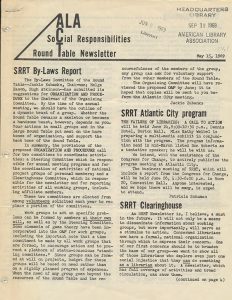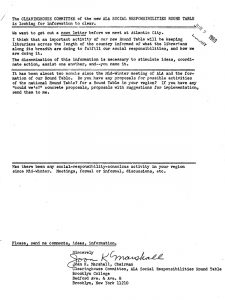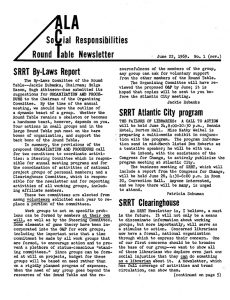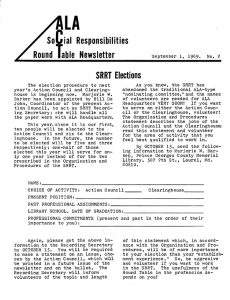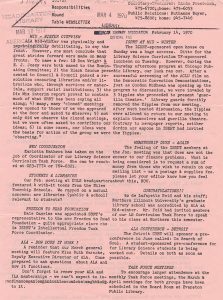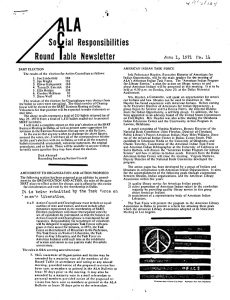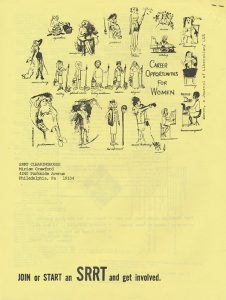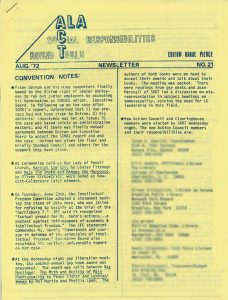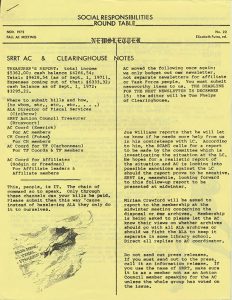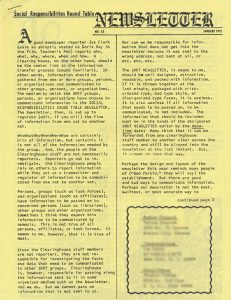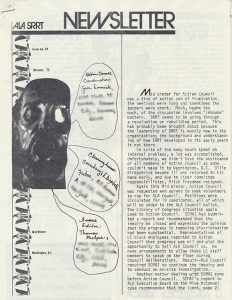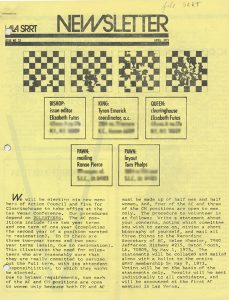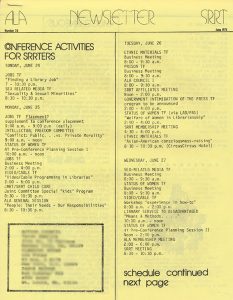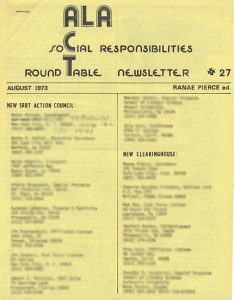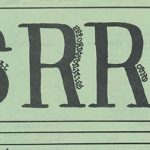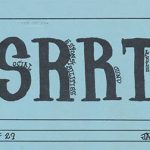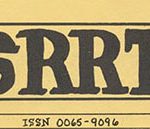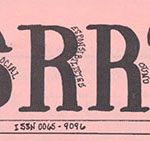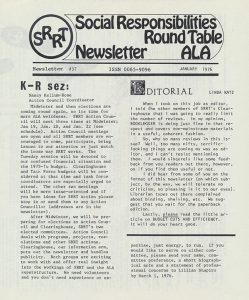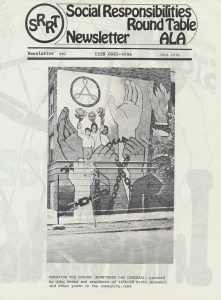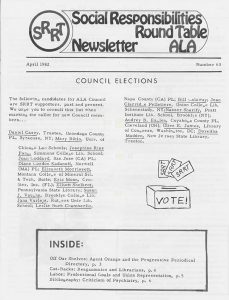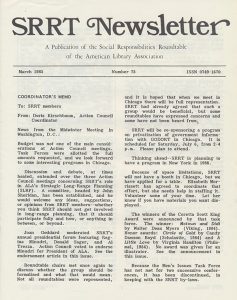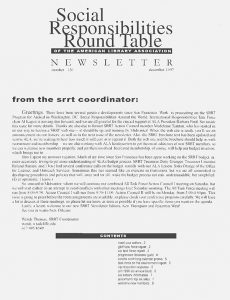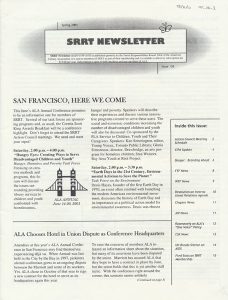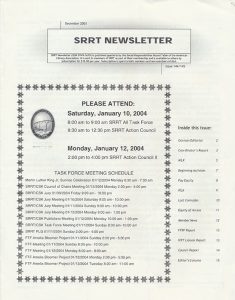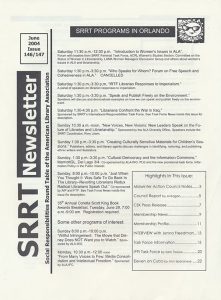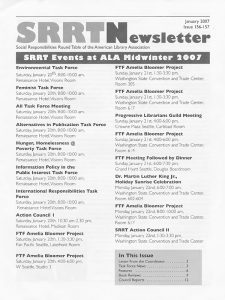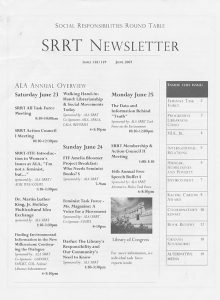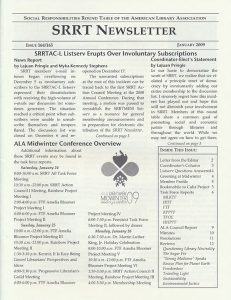Since 1969, the SRRT Newsletter has provided information resources on social issues affecting librarians, library communities, and libraries. Of course, older issues are still information rich for current and future readers.
Read on to learn more about the early art and history of SRRT Newsletter!
The Social Responsibilities Round Table (SRRT; also see Record Group 49) is a unit within the American Library Association which works to make the A.L.A. more democratic and to establish progressive priorities for both the A.L.A. and the library profession. Since 1969, the SRRT has published the SRRT Newsletter (Record Series 49/2/10) which is a rich information resource for alternative viewpoints on libraries and their role in society. You can also view the SRRT Newsletter online through the A.L.A. Institutional Repository (ALAIR).
Of course, for a concise history of the SRRT Newsletter, please see “A Brief History of the SRRT Newsletter” by SRRT Newsletter editor Myka Kennedy Stephens.
It was May 15, 1969, when the first newsletter from the Round Table Clearinghouse Committee published. A revised edition of the newsletter was reprinted just five weeks later in late June. Early issues featured a unified look, with a triangular masthead design, a two-column layout, and a foldable publication. Each issue included news briefs regarding national and state-level events.
*Research tip: When institutional chapters records are limited, early national publications can be the only source of information on state or regional activities. Don’t miss out!
For conferences, special conference editions were published as early as the 1970s. These special editions included information about exhibits and events of interest. Issue Number 7 might be the first of many future experimental layout changes. Printed horizontally rather than vertically, this conference issue’s unique layout stands out to inform readers. By Number 13, editors’ names would be included in the masthead too. By Number 14, in 1971, the first graphics were reproduced in SRRT Newsletter. At that time, issues began to include cartoons from the Liberation News Service (LNS). Early editors included Jackie Eubanks, Elizabeth Futas, Joan Goddard, Miriam Crawford, Judith Mowery, Robert Gutzke, and Thomas Phelps.
*Research tip: Special edition conference publications can be the sole source for identifying under documented events. If an archives does not have a record series produced by an individual or organization which you need information for, then consider how other individuals or groups might have shared such pertinent information with their audience.
Throughout the 1970s, SRRT Newsletter experimented often with form, as seen in different mastheads and layouts (seen above and below). By 1973, additional images were used playfully in relationship to the text on the page (as seen above in Number 24). Editors included Ranae Pierce, Elizabeth Futas, and Sanford Berman (Record Series 97/1/40). By this time the SRRT Newsletter included regular critical letters on issues in librarianship, as well as book reviews and announcements related to social publications.
* Research tip: Publications about social issues, like the SRRT Newsletter can provide researchers with access to public debates including both librarianship and beyond too. Such publications can help researchers contextualize social changes which might not be evident in other archival holdings like meeting minutes or annual reports. These publications are not be missed.
From 1973 until 1975, a single masthead design remained; although, the paper color would change with each issue. The mastheads included the ISSN for the first time too. Also at this time, the first advertisements were included, featuring alternative publications and publishers of interest to readers.
*Research tip: publication advertisements can tell readers about related organizations, people, or topics of relevance to readers.
By 1975, the layout would change significantly once more, returning to white paper but continuing to include higher resolution images. Editors included Linda Katz and Elizabeth Morrissett (Record Series 97/1/38).
* Research tip: Organizational publications about social issues, like the SRRT Newsletter, can also be rich with perspectives on their own organizations and the history of their peers. For example, when there is not published research into the history of an office, a unit, or an organization, sometimes, researchers can utilize criticisms and reviews as sources for history and for identifying key people too.
During the middle 1970s, the layout continued to evolve, and some of the first cover page photographs were included. By 1976 the masthead changed once more and it would remain so for almost an entire decade.
*Research tip: As the A.L.A. has expanded its influence nationally and internationally, publications like the SRRT Newsletter can provide a significant amount of documentation about social issues affecting librarianship in both North America as well as the world.
During the 1980s, more layout changes would continue to improve readability and to include even more information on every page. As seen in the images above, by 1985, the masthead changed and it remained for another decade, until 1997. Five years later, the layout changed again.
Finally, as recently as from 2004 through 2009, the layout shifted to a three column format with high resolution images and graphics too. In 2009, the SRRT Newsletter ceased its paper publication and it is exclusively available online (please see: ALAIR for copies at the ALA Archives). By simply browsing the titles, some researchers may also observe that during just forty years, publication images had changed from hand drawn art to high resolution photographs. Yet, at the same time, the same high quality content would continue uninterrupted. Since the the 1970s, the SRRT Newsletter, like many of its peer publications, had changed its layout over time, while maintaining a great amount of information about the past, present, and future of social issues affecting librarianship in the U.S. and the world.
Copies Available at Your ALA Archives
Physical copies SRRT Newsletter are available for viewing at the ALA Archives; however, not all copies are available yet. Please view Record Series 85/4/40, for information on which issues you can view or donate.
Got Something to Donate to the Story So Far?
There are so many great librarians doing so many great things and even the A.L.A. Archives can’t always keep-up with everyone all of the time. Not all librarians save the records of their careers and this makes preserving the heritage of librarians and their library communities difficult to document. Are you (or somebody you know) a member of the Social Responsibilities Round Table? We welcome you to share your part of ALA and library history in the comments or to contact us. We and our readers would like to hear from you.
